Aeroplan offers generous stopover and routing policies that allow you to book epic once-in-a-lifetime trips.
For those who wish to maximize their flying time and visit multiple destinations in one trip, a complex multi-stop Aeroplan redemption can be one of the best sweet spots that the program has to offer.
In this guide, we’ll walk through Aeroplan’s generous, albeit complex, fare combination logic and routing rules to help you book your own round-the-world trips.
In This Post
- Examples of Complex Aeroplan Trips
- What’s the Best Sweet Spot for Complex Trips?
- How Are One-Way Bounds Determined?
- Which Zones Can You Fly Through?
- Combining Up to Six One-Way Bounds
- Conclusion
Examples of Complex Aeroplan Trips
To begin, let’s price out a few different multi-stop itineraries using the Flight Reward Chart.
To keep things sufficiently aspirational, let’s focus on the business class pricing in our analysis. And to keep things simple, we’ll also exclude Air Canada’s dynamic pricing, assuming that travel takes place entirely on partner airlines or at the lower end of the dynamic range on any Air Canada flights.
(It’s true that dynamic pricing can negatively drive up the cost of award flights with Air Canada, but factoring it in to the below examples would result in additional complexity to an already complex situation.)
Before we get started with the examples of complex itineraries, make sure you’re familiar with the following basic facts about Aeroplan and how the program works:
- Aeroplan prices itineraries based on one-way bounds.
- Layovers are stays of less than 24 hours, while stopovers are stays of more than 24 hours.
- One stopover outside of Canada and the US)is permitted on a one-way bound for an additional 5,000 Aeroplan points.
- Open-jaws – flying into one city and out of another – can only take place between one-way bounds, not within one-way bounds.
- You can customize your routing between any two given points, including scheduling layovers of up to 24 hours.
- Each Aeroplan ticket can have a maximum of 12 flight segments if an Air Canada flight is included, and up to 16 flight segments if only partner flights are included.
Example 1: A Tour of the Asia-Pacific
- Vancouver–Tokyo (layover) on ANA
- Tokyo–Hong Kong (stopover) on ANA
- Hong Kong–Bangkok (layover) on Thai Airways
- Bangkok–Singapore (layover) on Singapore Airlines
- Singapore–Perth (destination; open-jaw) on Singapore Airlines
- Brisbane–Vancouver on Air Canada
Depending on whether long layovers suit your travel style or not, you can assume the layovers are either long layovers or convenient short connections – the cost breakdown is the same.
The first five flights will comprise a single one-way bound under the “Between North America and Pacific zones” chart. Since the total flown distance is 10,858 miles, this will cost 87,500 Aeroplan points in business class, plus 5,000 points for the stopover, for a total of 92,500 Aeroplan points.
Then, the Brisbane–Vancouver flight will form another one-way bound under the “Between North America and Pacific zone” chart. Since this flight’s distance is only 7,351 miles, this segment will only cost 75,000 Aeroplan points in business class.
In total, we’ll pay 167,500 Aeroplan points for this itinerary.
Example 2: A Classic Round-the-World Trip
- Toronto–Lisbon (layover) on TAP Air Portugal
- Lisbon–Rome (stopover) on TAP Air Portugal
- Rome–Istanbul (layover) on Turkish Airlines
- Istanbul–Bangkok (destination) on Turkish Airlines
- Bangkok–Seoul (stopover) on Thai Airways
- Seoul–New York (layover) on Asiana Airlines
- New York–Toronto on Air Canada
The route through Europe and Asia, in either the westbound or eastbound direction, is widely regarded as a “classic” round-the-world routing.
It brings you to some of the world’s most famous tourist attractions, allows you to fly on some of Star Alliance’s best airlines, and gives you the satisfaction of having completed a true round-the-world journey by crossing the Atlantic and Pacific.
The outbound flights to Bangkok comprise a single one-way bound, while the return flights via Seoul and New York comprise a second one-way bound.
Both are priced under the “Between North America and Pacific zones” chart, and since the respective total flown distances are 10,249 and 9,525 miles, both one-way bounds would cost 87,500 Aeroplan points each.
Add 10,000 Aeroplan points for the two stopovers, and we arrive at a total price of 185,000 Aeroplan points.
Example 3: Suboptimal Subcontinent
- Toronto–Lisbon (layover) on TAP Air Portugal
- Lisbon–Rome (stopover) on TAP Air Portugal
- Rome–Istanbul (layover) on Turkish Airlines
- Istanbul–New Delhi (destination) on Turkish Airlines
- New Delhi–Seoul (stopover) on Asiana Airlines
- Seoul–New York (layover) on Asiana Airlines
- New York–Toronto on Air Canada
This booking is almost exactly the same as in Example 2, except that New Delhi is set as the destination instead of Bangkok. As we’ll see, the pricing is drastically different.
The outbound flights to New Delhi comprise a single one-way bound, while the return flights comprise a second one-way bound. Both would be priced under the “Between North America and Atlantic zones” chart.
Since the respective total flown distances are 8,419 and 10,143 miles, both one-way bounds would cost 110,000 Aeroplan points each.
Add 10,000 Aeroplan points for the two stopovers, and we arrive at a total price of 230,000 Aeroplan points.
Example 4: North & South Atlantic
- Montreal–London (stopover) on Air Canada
- London–Abu Dhabi–Johannesburg (destination) on Etihad Airways
- Johannesburg–Addis Ababa–São Paulo (stopover) on Ethiopian Airlines
- São Paulo–Montreal on Air Canada
The ability to cross the North Atlantic in one direction and the South Atlantic in the other, while visiting Europe, South Africa, and South America all in one trip, has always been one of the possibilities that I find the most intriguing for an Aeroplan redemption.
In this example, the outbound flights to Johannesburg comprise a single one-way bound, while the return flights comprise a second one-way bound.
Both are priced under the “Between North America and Atlantic zones” chart, and since the respective total flown distances are 10,580 and 13,729 miles, both one-way bounds would cost 110,000 Aeroplan points each.
Add 10,000 Aeroplan points for the two stopovers, and we arrive at a total price of 230,000 Aeroplan points.
Example 5: A Five-Continent Combo
- Toronto–Vancouver (layover) on Air Canada
- Vancouver–Sydney (stopover) on Air Canada
- Sydney–Singapore (destination) on Singapore Airlines
- Singapore–Abu Dhabi–Johannesburg (stopover) on Etihad Airways
- Johannesburg–Zurich (layover) on Swiss
- Zurich–Toronto on Air Canada
The outbound flights to Singapore comprise a single one-way bound, while the return flights comprise a second one-way bound.
Both are priced under the “Between North America and Pacific zones” chart, and since the respective total flown distances are 13,749 and 16,812 miles, both one-way bounds would cost 115,000 Aeroplan points each.
Add 10,000 Aeroplan points for the two stopovers, and we arrive at a total price of 240,000 Aeroplan points.
What’s the Best Sweet Spot for Complex Trips?
As we’ve seen in the above examples, maximizing Aeroplan’s routing and stopover rules can be very sensitive to the destination you choose.
Examples 2 and 3 are exactly the same, except that Bangkok has been swapped with New Delhi as the destination. These two cities aren’t that far apart geographically, but going to New Delhi ends up being 45,000 Aeroplan points more expensive than going to Bangkok.
Why? It’s all because of the differences between the North America–Atlantic zones and North America–Pacific zones charts.
If you run the numbers on these two charts relative to each other, you’ll see that the Pacific chart is significantly more generous in terms of how much distance you can fly for a given number of Aeroplan points.
Looking at the Atlantic chart’s maximum distance band, anything over 8,000 miles costs 110,000 Aeroplan points.
In comparison, the Pacific chart allows you to fly up to 11,000 miles and still pay only 87,500 Aeroplan points.
In fact, this particular cell on the North America–Pacific zones chart – the distance band of 7,501–11,000 miles in business class – is arguably the single best “sweet spot” in terms of booking a complex Aeroplan trip without paying an over-exorbitant amount of points.
11,000 miles will let you route from via Europe on your way to Asia from North America, or via Asia on your way to Australia.
If you can keep both directions of travel under 11,000 flown miles, you’d pay 185,000 Aeroplan points for a trip with two stopovers.
Unfortunately, if you want to book a multi-stop trip to Africa, the Middle East, or India (as seen in Example 4), you’re likely looking at a steeper cost, due to the fact that the North America–Atlantic zones chart is relatively less generous with its distance allowances.
How Are One-Way Bounds Determined?
Let’s further explore the logic behind where a one-way bound “breaks” and a new one-way bound begins.
After the entire itinerary has been sketched out by an Aeroplan call centre agent, the system applies “one-way bound logic” to the entire proposed itinerary to divvy it up into appropriate one-way bounds.
The system then calculates the price of each one-way bound individually (just like we did above), and adds it all up to arrive at the total points price.
So, what does that “one-way bound logic” actually look like?
Starting from the origin, the logic analyzes the entire trip segment-by-segment. After every segment, any of the following criteria, listed in order of priority, will mark the “breaking” of the one-way bound and the beginning of a new bound:
- A second stopover point (or a first stopover point within Canada/US)
- An open-jaw
- Backtracking to the same airport or country after already passing through
- Circuitous routing: As a general rule of thumb, this refers to flying 100% more than the direct distance between two points; however, there are also further rules on allowable transit regions (as we’ll discuss below).
- Reaching a maximum of six segments
Frankly, this is mind-numbingly complex stuff. Just as we did before, I think the easiest way to illustrate what’s going on is through a series of examples.
Example 1: Bound Breaks with Second Stopover
- January 1: Toronto–Lisbon
- January 5: Lisbon–Paris
- January 12: Paris–Toronto
This one’s pretty straightforward. None of the bound-breaking criteria are triggered upon reaching Lisbon. Upon reaching Paris, the logic recognizes that there is a second stopover (a stay of extended duration), so the bound breaks due to Criterion #1.
The second bound is simply the Paris–Toronto return segment.
This trip will be priced on the basis of two one-way bounds: Toronto–Lisbon–Paris and Paris–Toronto.
(The pricing of this sample trip, as well as all the sample trips below, is left as an exercise to the reader.)
Example 2: Bound Breaks with Open-Jaw
- February 1: Montreal–Frankfurt
- February 4: Munich–Istanbul
- February 9: Istanbul–Montreal
Upon flying into Frankfurt and flying out of Munich, the bound breaks due to Criterion #2.
The next bound starts at Munich and goes to Istanbul, where it doesn’t break. Upon reaching Montreal, the journey concludes. Munich–Istanbul–Montreal was not determined to be circuitous, as it’s only 50% above the direct distance between Munich and Montreal.
This trip will be priced on the basis of two one-way bounds: Montreal–Frankfurt and Munich–Istanbul–Montreal.
Example 3: Bound Breaks with Circuitous Routing
- March 1: Montreal–Frankfurt
- March 4: Munich–Abu Dhabi
- March 12: Abu Dhabi–New York
- March 12: New York–Montreal
Using the same logic as above, the first bound breaks at Frankfurt and the second bound begins from Munich to Abu Dhabi.
Upon adding the Abu Dhabi–New York flight, this routing now becomes “circuitous” due to Criterion #4, because Munich–Abu Dhabi–New York is 140.5% above the direct distance between Munich and New York.
The second bound therefore must break in Abu Dhabi, and the third bound goes from Abu Dhabi to New York (for a layover) and then to Montreal.
This trip will be priced on the basis of three one-way bounds: Montreal–Frankfurt, Munich–Abu Dhabi, and Abu Dhabi–New York–Montreal. It’ll definitely be more expensive than if a trip priced with only two one-way bounds.
Note that the “100% over the direct distance” rule for circuitous routings is only meant to be an illustrative rule of thumb.
Indeed, who’s played around with a few different city combinations on the search engine will probably have discovered that this rule of thumb can turn out to be very flexible.
Take, for example, Taipei–Paris–Abu Dhabi via EVA Air and Etihad Airways on a single one-way bound, even though it’s 125% over the direct distance, pricing according to the “Between Atlantic and Pacific zones” chart.
These examples are few and far between, but serve to illustrate that the “100% over the direct distance” circuitous routing rule is not necessarily hard-and-fast.
Example 4: Bound Breaks with 6-Segment Limit
- April 1: Vancouver–Tokyo
- April 2: Tokyo–Seoul
- April 3: Seoul–Beijing
- April 4: Beijing–Hong Kong
- April 10: Hong Kong–Bangkok
- April 11: Bangkok–Ho Chi Minh City
- April 12: Ho Chi Minh City–Singapore
- April 13: Singapore–Perth
This traveller wants to do a bunch of long layovers, plus one stopover in Hong Kong, on their way to Perth.
The logic doesn’t run into any trouble in Tokyo, Seoul, or Beijing. In Hong Kong, we have a stopover, but it’s only the first stopover of the bound, so we’re still good. Bangkok is fine, too.
But then we get to Ho Chi Minh City, and Criterion #5 is triggered: we’ve already had six segments on this one-way bound. The bound therefore breaks in Ho Chi Minh City, and the remaining flights via Singapore form the second bound.
This trip will be priced on the basis of two one-way bounds: Vancouver–Ho Chi Minh City and Ho Chi Minh City–Perth. Sorry folks, you won’t be able to do 16-segment one-way runs with 15 long layovers!
Which Zones Can You Fly Through?
In addition to the “100% over the direct distance” rule for circuitous routings that we discussed above, let’s also look at how Aeroplan’s zonal restrictions work.
These restrictions specify the terms of which zones you can transit through, or have a stopover in, on your way from one location to another.
On this topic, Aeroplan’s Flight Reward Policy provides the following guidance:
To put these guidelines to the test, we’ve attempted to piece together various itineraries with the Aeroplan contact centre, with the following results.
North America to/from Europe: Must travel across the Atlantic Ocean
Proposed itinerary:
- Los Angeles–Tokyo (stopover), on ANA
- Tokyo–Frankfurt, on ANA
Not priced successfully. Some agents are able to put it on the same ticket as two separate one-way bounds, while others are not able to combine it on the same ticket at all.
North America to/from Middle East: Must travel across the Atlantic Ocean
Proposed itinerary:
- Los Angeles–Tokyo (layover), on ANA
- Tokyo–Abu Dhabi (stopover), on Etihad Airways
- Abu Dhabi–Johannesburg, on Etihad Airways
Not priced successfully as a single one-way bound.
Note that both of the above examples are under 100% of the direct distance flown, so they shouldn’t be struck out on the basis of being a circuitous routing.
Instead, it’s the zonal transit rules at play here that prevent the itineraries from being priced as a single one-way bound.
North America to/from South America: Must travel wholly within the Western Hemisphere
Proposed itinerary:
- Toronto–Lisbon (stopover), on TAP Air Portugal
- Lisbon–São Paulo, on TAP Air Portugal
Not successfully priced as a single one-way bound or indeed a single ticket.
Proposed itinerary:
- Cancún–Lisbon (stopover), on TAP Air Portugal
- Lisbon–Recife, on TAP Air Portugal
Not successfully priced as a single one-way bound or indeed a single ticket.
The first example here is only 67% over the direct distance, whereas the second example is 104% over.
The fact that neither can be booked as a one-way bound, nor even issued on the same ticket, indicates that travel between two points in the Americas needs to remain entirely within the Americas.
North America to/from Asia: Can transit through Europe
After verifying the rules around which zones you can’t transit through, let’s now take a look at some zones that you can transit through from one place to another, which we’ve verified through further sample itineraries priced out via the Aeroplan website or contact centre.
As a general rule, transiting Europe on the way to Asia is perfectly fine, and this is indeed the basis of the “Atlantic/Pacific arbitrage” sweet spot.
Proposed itinerary:
- Toronto–Lisbon (layover), on TAP Air Portugal
- Lisbon–Rome (stopover), on TAP Air Portugal
- Rome–Istanbul (layover), on Turkish Airlines
- Istanbul–Bangkok (destination), on Turkish Airlines
- Bangkok–Seoul (stopover), on Thai Airways
- Seoul–New York (layover), on Asiana Airlines
- New York–Toronto, on Air Canada
Priced successfully: 185,000 Aeroplan points in business class (87,500 points each for the two one-way bounds to Bangkok, plus 10,000 points for the two stopovers)
Europe to/from Asia: Can transit through North America
This one is very interesting: whenever you’re flying from Asia to Europe, Asia to Africa, Australia to Europe, etc., then transiting through North America is possible!
And although stopovers in Canada or United States are not permitted, stopovers in Mexico are. Consider the following successfully-priced itinerary.
Proposed itinerary:
- Denpasar–Taipei (layover), on EVA Air
- Taipei–Los Angeles (layover), on EVA Air
- Los Angeles–Cancún (stopover), on United
- Cancún–Lisbon, on TAP Air Portugal
Priced successfully: 115,000 Aeroplan points in business class (110,000 points for a Pacific–Atlantic award of 7,001+ miles, plus 5,000 points for the stopover)
If you’d like to string together multiple premium redemptions over the course of a year and don’t mind popping down to Mexico a few times per year, then the Mexico stopover on an Atlantic–Pacific award could be a very creative way to schedule some extensive globetrotting while saving yourself a fair chunk of points.
Travel within the Atlantic or Pacific zones: Can transit each other
Unlike the North America and South America zones, the Atlantic and Pacific zones seem to be more flexible in terms of whether a one-way bound between two points in one zone can cross into the other.
The most interesting consequence of this can be seen in a search for Seoul–Sydney, which returns a very fun routing on Etihad Airways via Abu Dhabi, even though it’s 127% over the direct distance!
Indeed, Aeroplan’s Flight Reward Policy states that transiting in a different zone on travel between two points in a single zone is generally not permitted, but also mentions that there will sometimes be exceptions to this rule.
Combining Up to Six One-Way Bounds
So far, our analysis has focused on one-way or round-trip bookings (or, in Aeroplan’s language, bookings that consist of up to two one-way bounds).
Here’s the final layer of intrigue: Aeroplan actually allows you to have up to six “one-way bounds” or “directions” on the same ticket!
The format would be A–B–C–D–E–F–A, or Montreal–London–Istanbul–Bangkok–Sydney–Tokyo–Montreal, to take a nice round-the-world example.
And within each of these one-way bounds, you’re allowed to add a stopover for 5,000 Aeroplan points, meaning that your number of extended stops can technically reach a maximum of 11.
So let’s allow our imagination to run wild: Montreal–Newark–London; London–Athens–Istanbul; Istanbul–Dubai–Bangkok; Bangkok–Singapore–Sydney; Sydney–Beijing–Tokyo; Tokyo–Chicago–Montreal. You’re able to stop for an extended period in all of those places.
You can count these up to make sure that there are six one-way bounds, or directions of travel, in total.
We can even go one step further and add open-jaws into the mix.
Consider this itinerary: Montreal–Newark–London; Paris–Athens–Kos; Istanbul–Dubai–Bangkok; Bangkok–Singapore–Perth; Sydney–Beijing–Osaka; Tokyo–Chicago–Montreal.
With open-jaws between several of the one-way bounds, you’ll be able to visit an additional four cities on your epic round-the-world trip – all while “connecting the dots” between your quartet of open-jaws with the Eurostar, the ferry across the Aegean Sea, the Indian Pacific train across Australia, and the Shinkansen, respectively.
Of course, this all sounds a little too good to be true. So what’s the catch?
Well, the catch is that each of the six one-way bounds is priced individually, and the costs for the total journey will therefore add up very quickly.
Let’s run the numbers on our most extreme example above, assuming fixed partner prices and the lower end of the spectrum for Air Canada’s dynamic prices:
- Montreal–Newark–London: 35,000 points in economy class or 60,000 points in business class
- Paris–Athens–Kos: 12,500 points in economy class or 25,000 points in business class
- Istanbul–Dubai–Bangkok: 40,000 points in economy class or 60,000 points in business class
- Bangkok–Singapore–Perth: 25,000 points in economy class or 45,000 points in business class
- Sydney–Beijing–Osaka: 37,500 points in economy class or 60,000 points in business class
- Tokyo–Chicago–Montreal: 50,000 points in economy class or 75,000 points in business class
Adding it all up, the entire redemption would cost a staggering 200,000 Aeroplan points in economy or 325,000 Aeroplan points in business class.
Add another 30,000 points for adding six stopovers, and you’ll get a total of 230,000 Aeroplan points in economy or 355,000 Aeroplan points in business class.
Don’t get me wrong, 355,000 Aeroplan points is incredible value for a business class round-the-world trip that lets you visit 15 different places, but it’ll certainly take a fair bit of work to rack up those 355,000 points in the first place.
One final note: this is where the true power of Aeroplan Super Elites’ Priority Rewards comes in to play.
If you’re a Super Elite who can redeem Priority Rewards on worldwide business class tickets, or if you can convince a Super Elite friend to spare you a Priority Reward voucher, then you’d be able to book this entire single award for a staggering 50% off: only 177,500 Aeroplan points!
That sounds like a killer deal all of a sudden, doesn’t it?
Conclusion
Complex multi-stop bookings, if you can pull them off, are one of the most outstanding sweet spots of the Aeroplan program.
For those of us who’d like to squeeze in even more flights and stops along our round-the-world trips, it’s important to familiarize ourselves with the “one-way bound logic” that underpins complex customized redemptions using Aeroplan points.
Sure, we might get a few migraines from trying to understand all the rules, but it’ll all be worthwhile when we’re sipping our Champagne on the journey to a maximum of 11 different extended stops or 15 different cites including open-jaws.


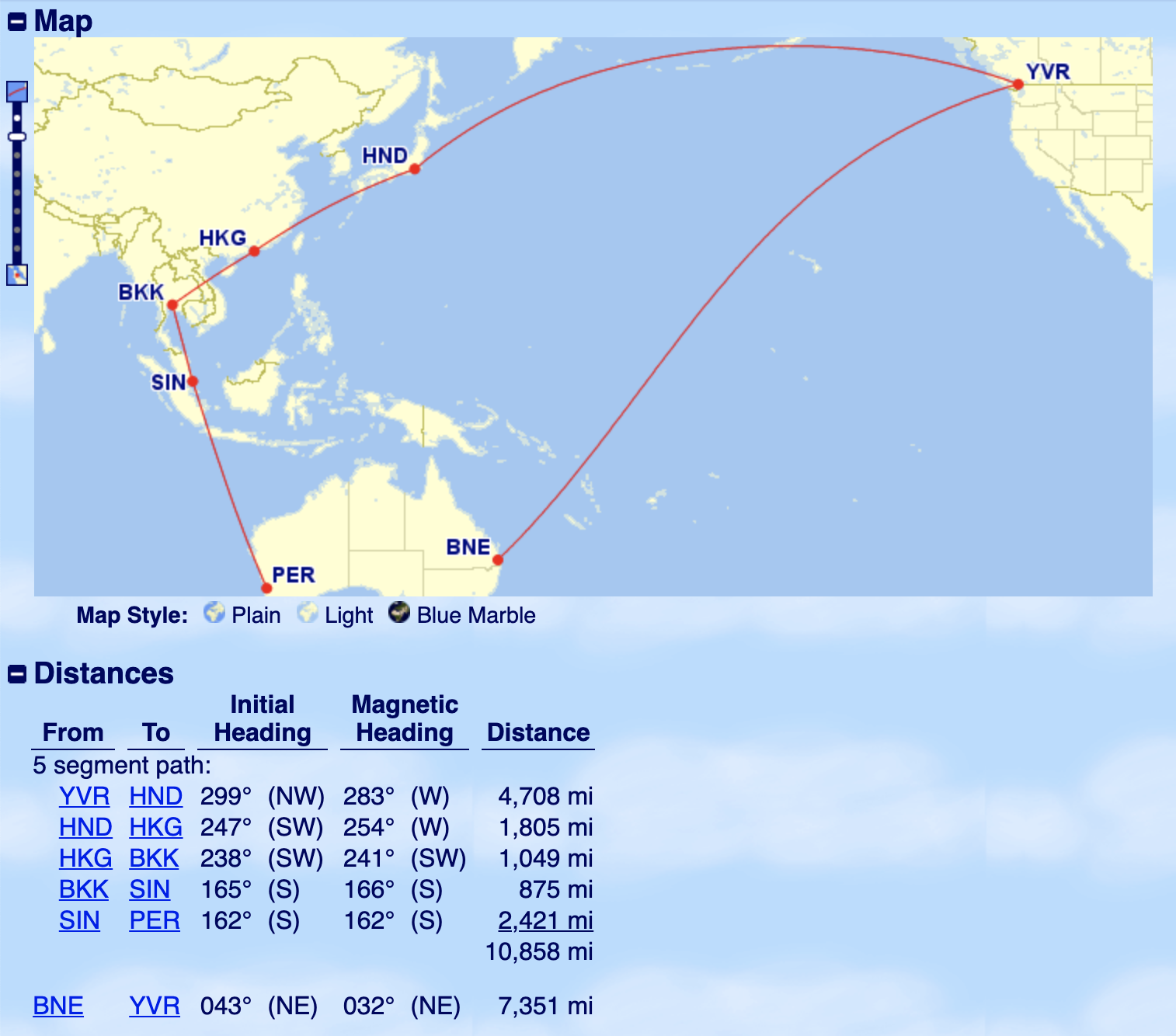
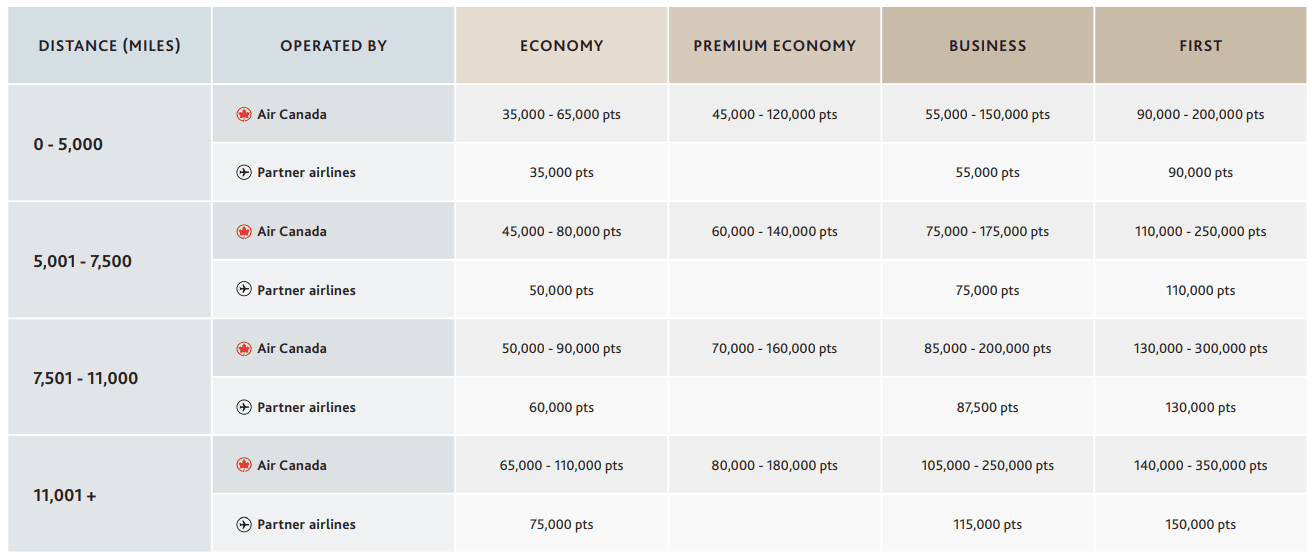
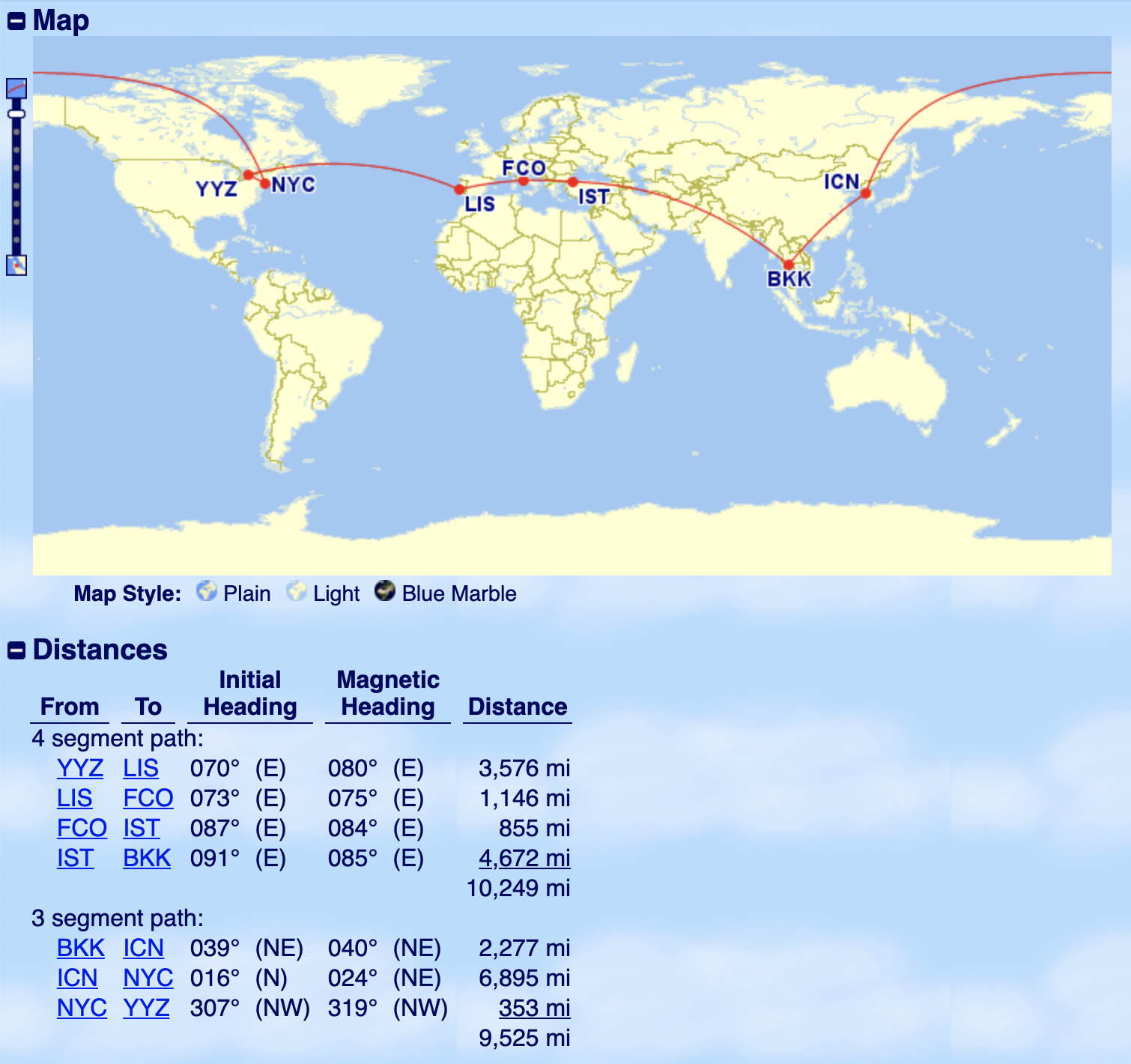
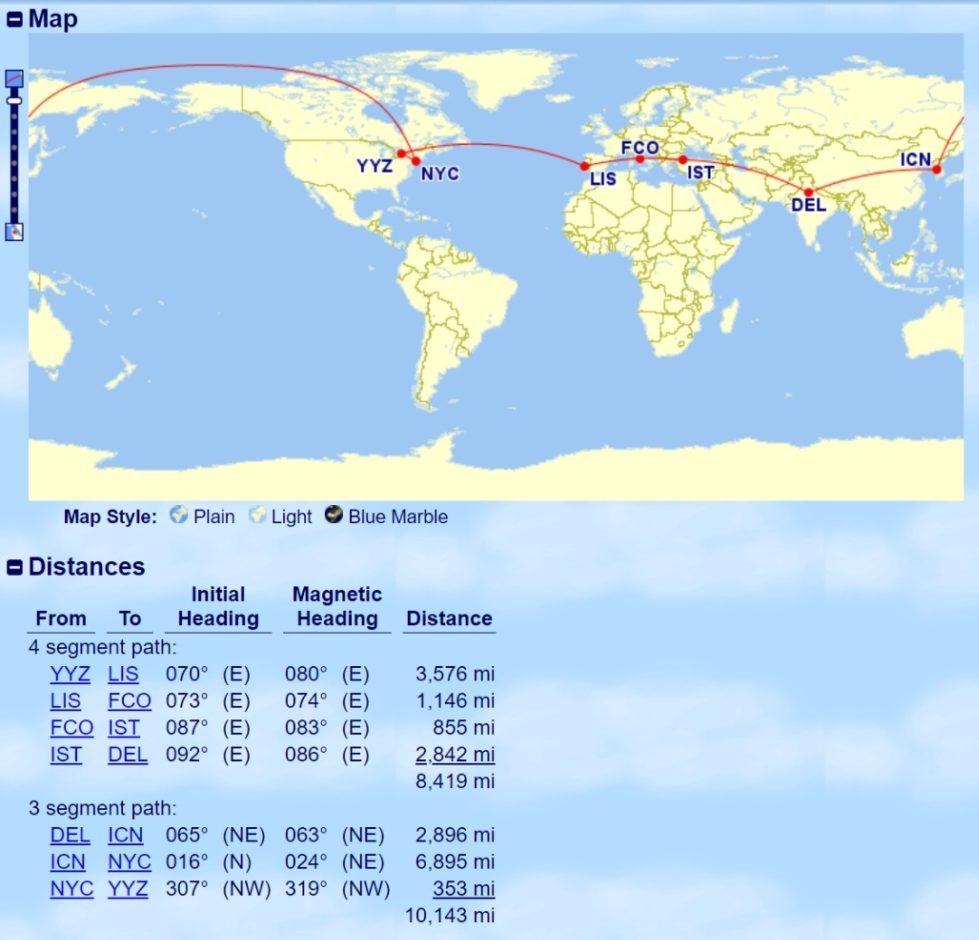
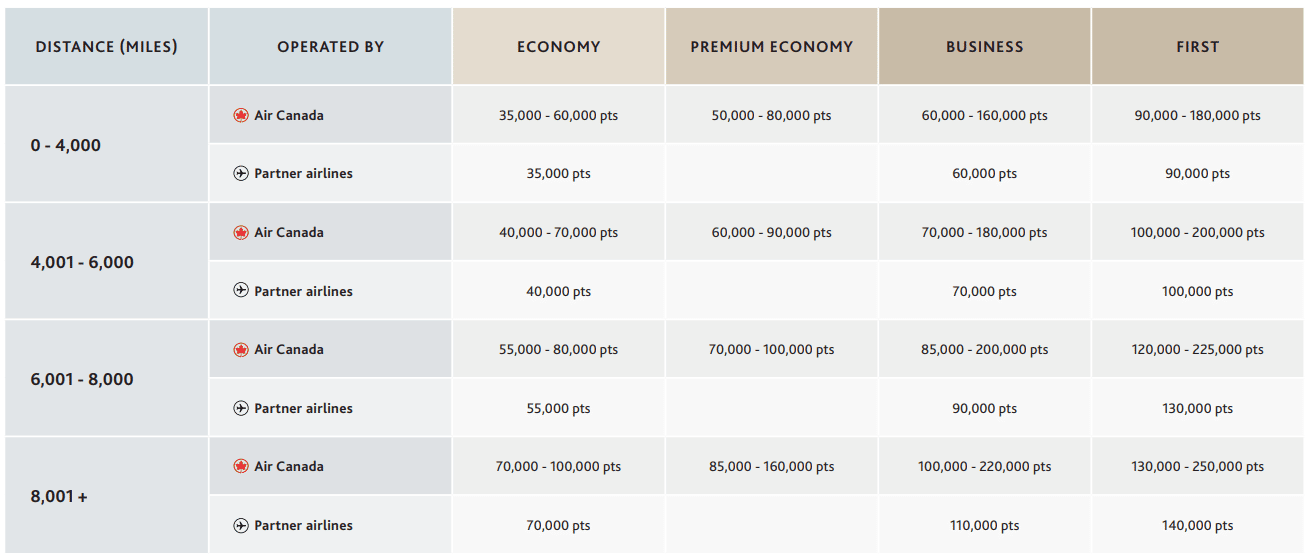
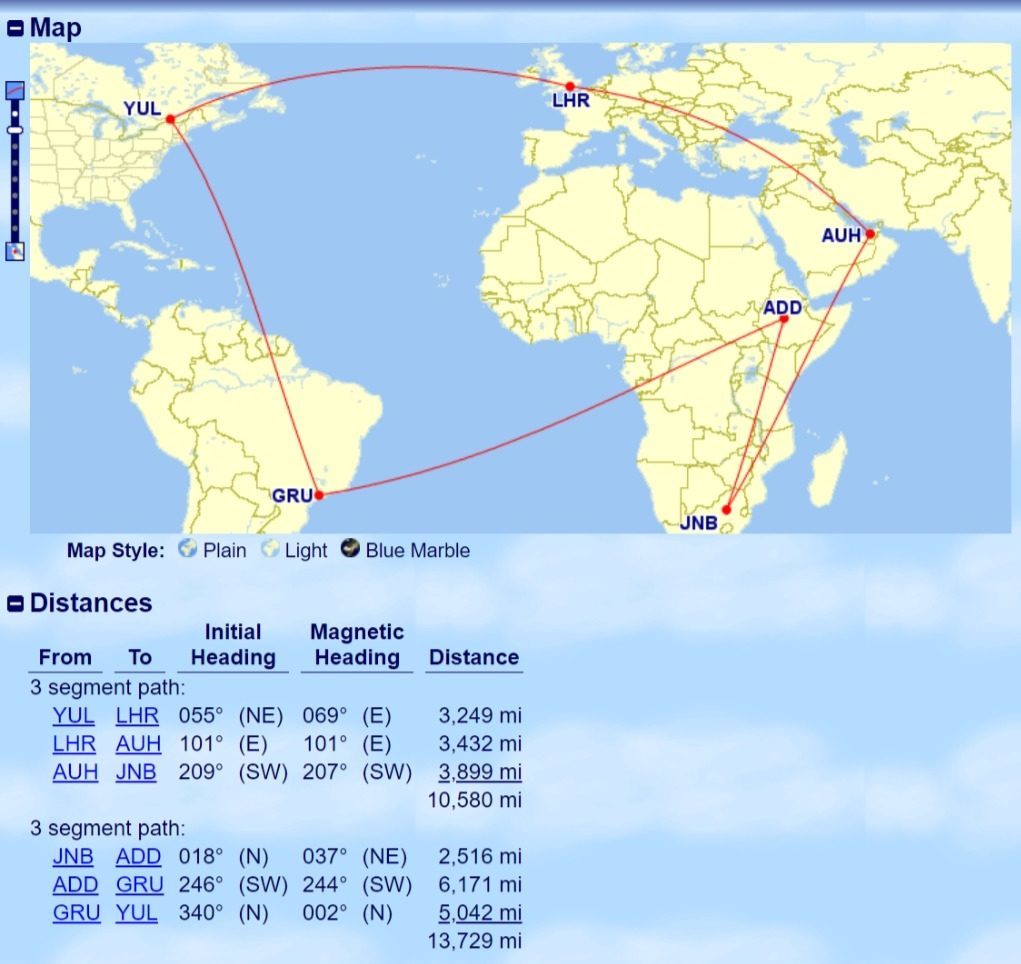
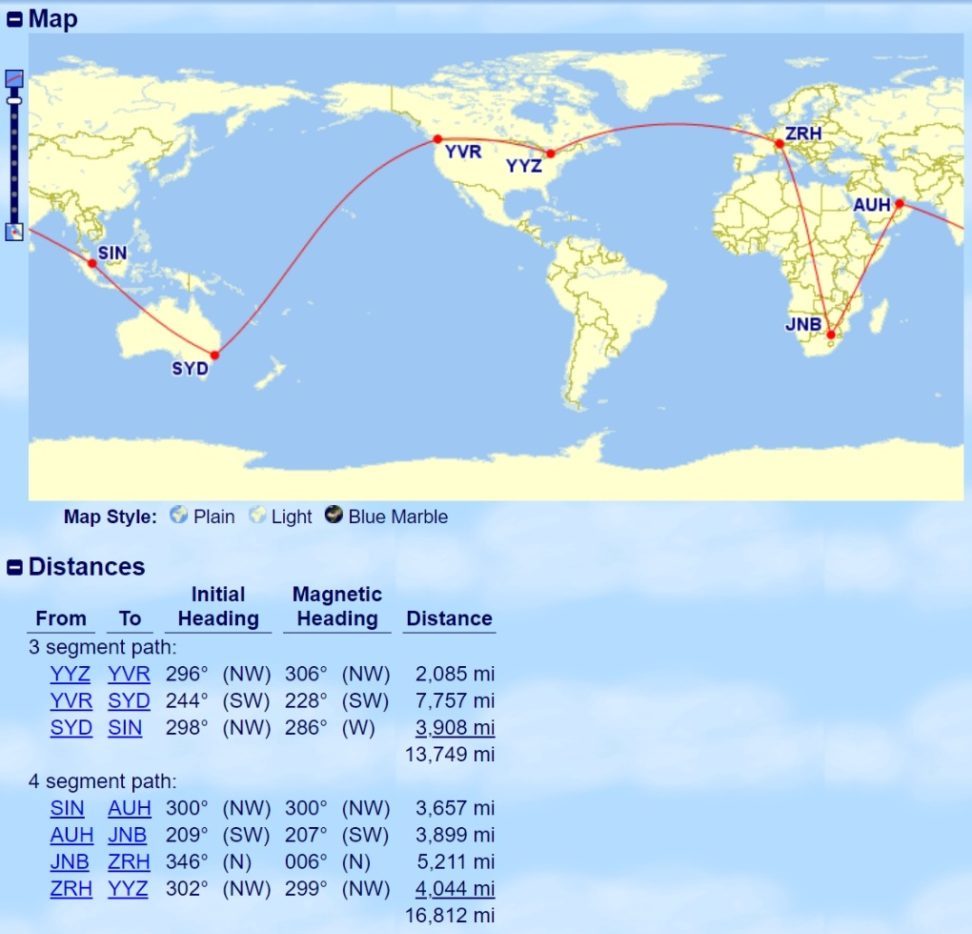

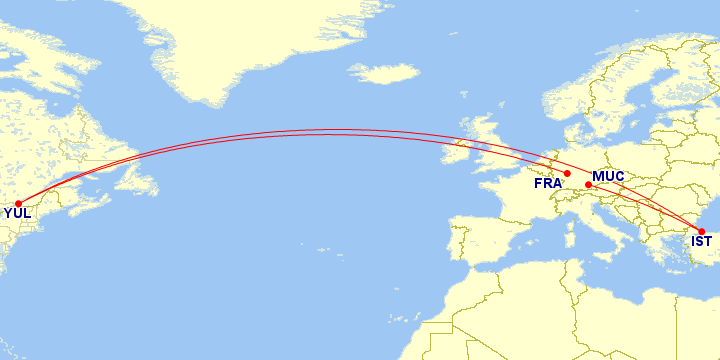
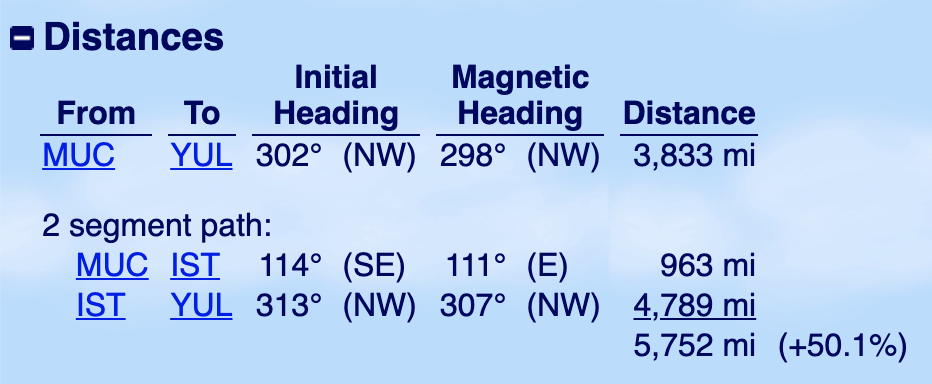
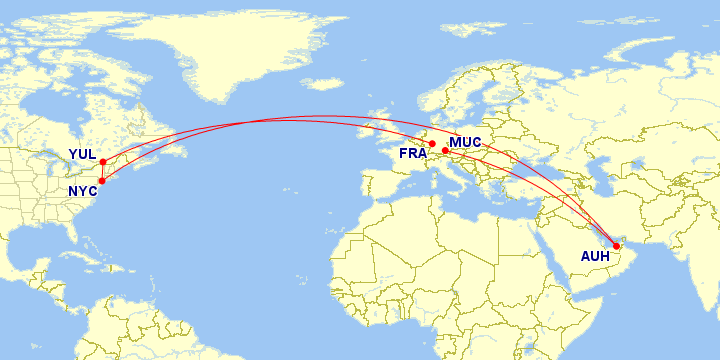
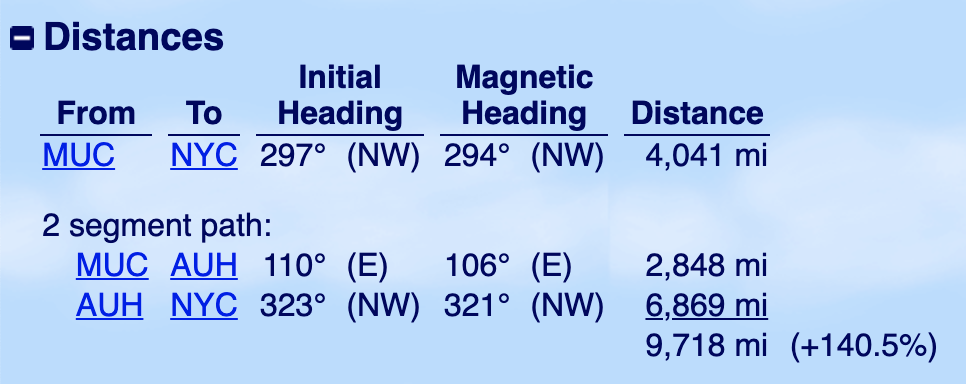


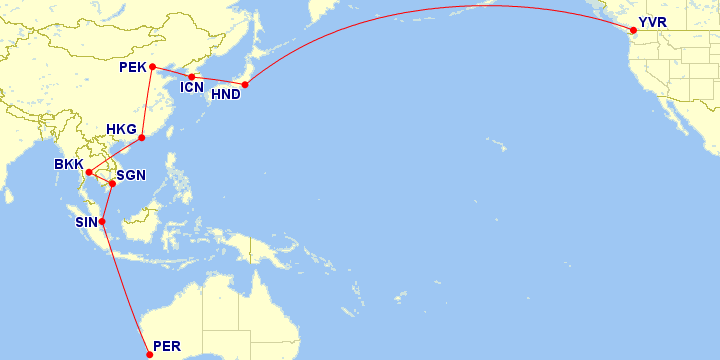

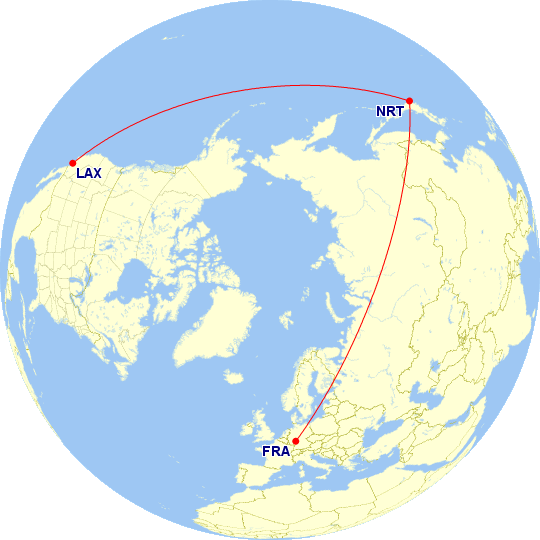

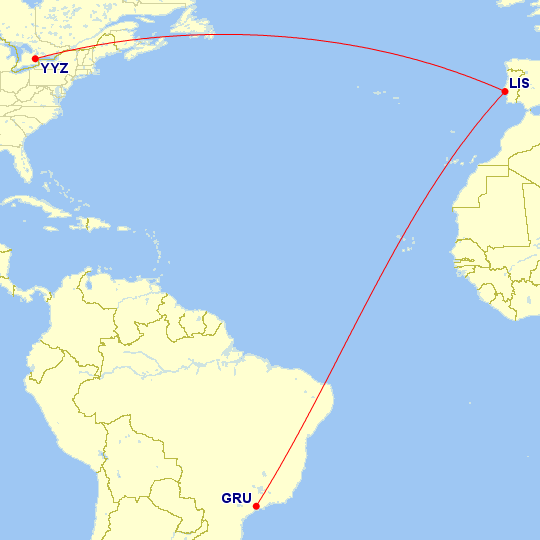
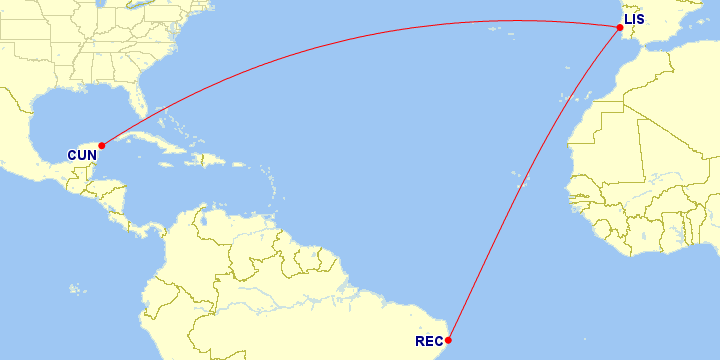

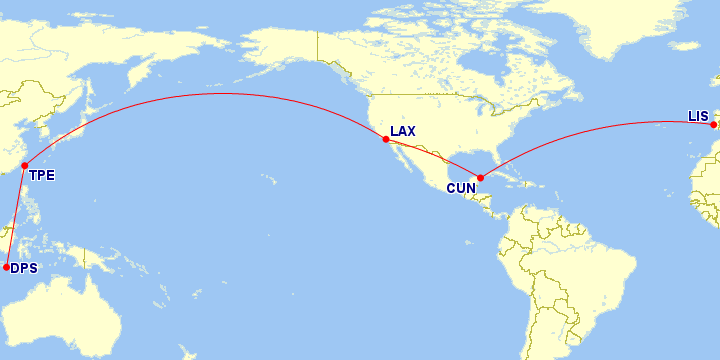

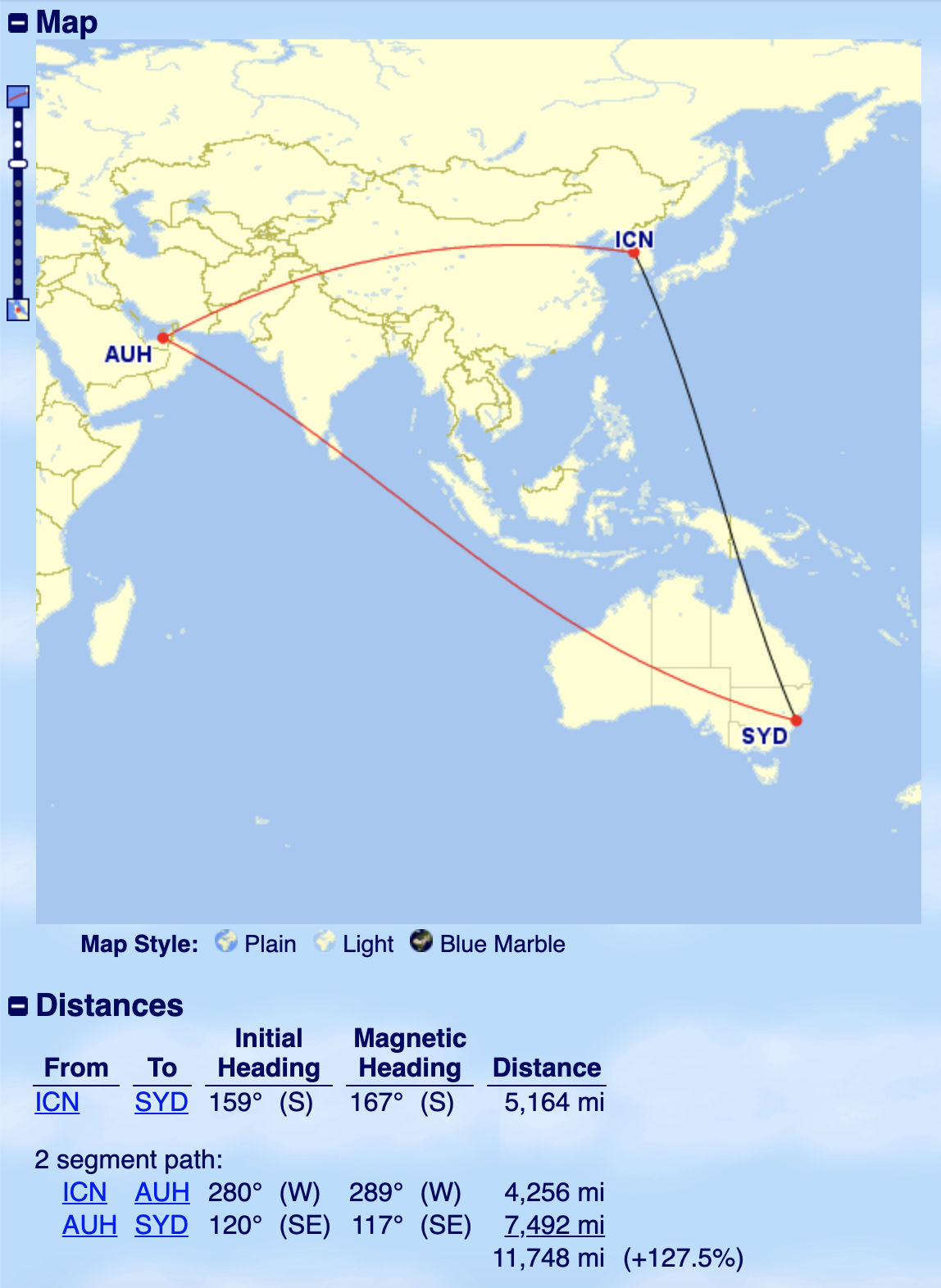
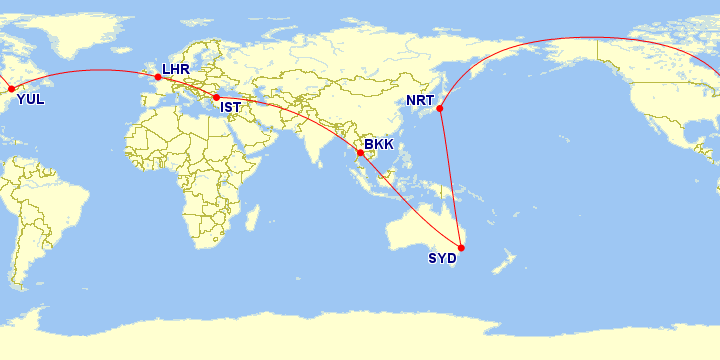
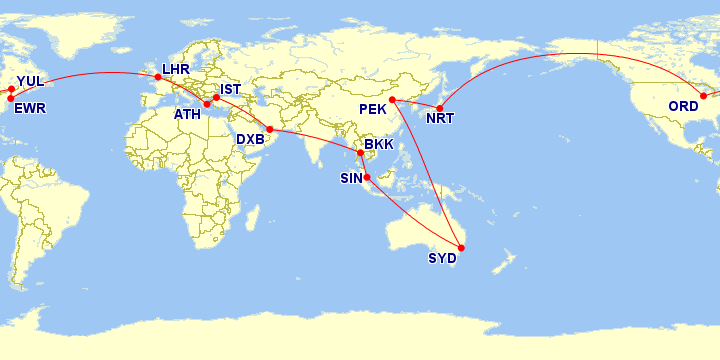
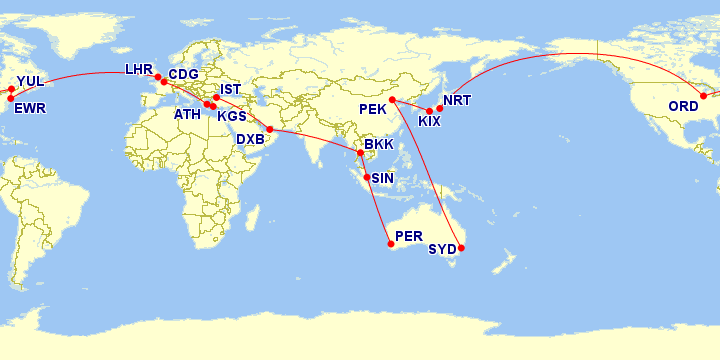










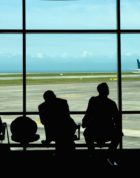
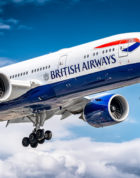

Amazingly helpful post, so much detailed information and background accompanied by a thorough and responsive comments section! Thank you all. I am just wondering how I actually make these bookings – online using the Aeroplan site? Which section of the Aeroplan site?
Hi, I’m just double-checking if the “open-jaw counts as a segment rule” invalidates both of these rules or only #2:
1: 12 segments max on one ticket if there’s at least one AC flight
2: 16 segments max on one ticket if no AC flights.
e.g. is this allowed on a single ticket:
YVR-YUL-ZRH-AMS-CPH-IST-SIN; (YVR-YUL on AC)
SGN-BKK-HKG-PEK-ICN-HND-YVR;
If they allow routing like this it saves some fees vs 2 tickets. Isn’t the 16 max limit a star alliance booking system constraint, but the 12 segment rule appears arbitrary for the new aeroplan, so slight chance it’s only manually enforced?
Hi! Thank you for the content. I have a problem with my itinerary but I don’t what it is.
I’m trying to book a crazy first/business one way. CKG-HND-FRA (stopover) FRA-GVA-AUH-IAD (final). They are only able to book it in 2 or 3 segments… I’m under the MPM, under the 6 flights and respect the transit zone… I really want to try “the suite”! Do you know my error please? 🙂
I believe the issue is the direct distance between CKG and AUH (rule 4 in the article). The “bounds” are analyzed segment by segment so CKG-HND-FRA-GVA-AUH is more than double the direct distance between CKG and AUH.
Hi! Thank you for the content. I have a problem with my itinerary but I don’t what it is.
I’m trying to book a crazy first/business one way. CKG-HND-FRA (stopover) FRA-GVA-AUH-IAD (final). They are only able to book it in 2 or 3 segments… I’m under the MPM, under the 6 flights and respect the transit zone… Do you know my error please? 🙂
Hi!
Do you think Aeroplan allows 2 stopovers and 1 open jaw on a reservation? For instance:
YUL-ZRH (stop)
ZRH-IST (destination)
NAV( in Turkey)-ZRH (stop)
ZRH-YUL
Thank you!
They currently do not.
Trying to figure out what the maximum for layovers is on a single one-way bound award redemption? Is it 15? Assuming only partner airlines?
Changed my final destination to KUL, 10,713 miles total.
Booked for 85,000 + 5,000 business. Thanks
Glad it worked out!
Tried to book 2 tickets in Business YUL-CGK with a stopover in DEL.
Available info led me to believe that it would be ”North America to Pacific zones” distance 7,501-11,000 miles so 85,000 + 5,000 for stopover = 90,000 total p.p.
My routing was YUL-ZRH (12h) ZRH-IST (20h) IST-AUH (20h) AUH-DEL (stopover) DEL-BKK (3h) BKK-CGK final destination.
First agent quoted 110,000 p.p. explaining the distance on the new chart applies to the total of all flights 11,440 miles.
Second agent I called quoted 115,000 p.p.
Confused
Your routing is 11,378 miles in distance, so it’d be 105,000 points + 5,000 points for the stopover = 110,000 points in total.
Hello!
I phoned aeroplan today to make a booking as follows:
YYZ→FCO (stopover)→AUH→KUL (destination) (10,587 miles).
The representative was insistent that I could do this booking on line, even as I tried to inform him that I would like to make the booking as a flight from YYZ-> KUL with a stopover in FCO (in economy: 60k +5k =65k), not as two single one way tickets (YYZ->FCO and FCO->KUL) (which in economy, prices out to 37.3k+50k=87.3k).
Does anyone have experience/suggestions with the terminology/language that I should use with the aeroplan representative?
Thanks in advance!
I came across a link you had provided where the search engine would locate all flights between two cities as well as all the airlines that flew between them. Clicking on the dates of the flights would expand and show the arrival and departure times. Just can’t seem to remember the name of which blog post had it. Must remember to bookmark right away.
So glad to have found a Canadian based blogger and with all these sweet deals with Aeroplan 🙂
Good day
Thanks for the wonderful posting
Which site/ map did you used to do the mileage required from city to city as shown as posted in order to do a mini trip around the world
Great Circle Mapper: https://princeoftravel.com/blog/how-to-use-great-circle-mapper-like-a-pro/
Hi Matt
Thanks a million for the email.
Love the way you explain in detail how to use the MAP using your write-up
Wishing you al the best for next year.
Ricky
Thanks for this information, very helpful, as well as your Tweets. Question, I travelled to JNB last year, YVR-TPE-SIN-JNB and return via SIN on EVA, SIA and ANA. Looks like I have to call Aeroplan to do something similar next year. Before I call would I be able to do YVR-NRT-AUH-JNB and back via AUH and NRT? or would I have to return via Europe? I can find availability on all journey segments just wondering if routing is possible?
Thanks!
Don
Hey Don, take a look at this post on complex routings now that the new program has launched: https://princeoftravel.com/blog/new-aeroplan-an-early-look-at-complex-routings/
Seems like routing through Asia en route to the Middle East / South Africa will not be possible on a single award.
Thank you Ricky, appreciate it, I’ll try Plan B.
Keep up the good work!
Wow, just WOW Ricky. I read all the way to the 6 trips combined example and decided if you can arrange that in 2 to 4 hours for me I would be happy to the the $500 of so it would cost. Brilliant analysis, no need to bookmark since I know PoT is the only resource I need to refer to for Air Canada. Possibly your best work yet .
I am trying to recreate my mRTW I had to cancel
I want to take the Etihad First class apartments starting from YVR.
I had originally had to buy 2 separate award tickets. YVR-YUL (25,000 AP) and then YUL-ZHR-CDG(stop)-AUH-SYD(dest) (110,000 AP) = 135,000 AP (my trip back home was trans pacific)
But it seems like now I can theoretically do the same for the same price on 1 ticket this time. However, YVR-SYD = 7,757 mi (15,514 mi) so I can’t make YVR-CDG-AUH-SYD (15,698 mi) work unless they are a bit flexible with the 100% rule.
So can I go SYD-AUH-CDG(stop)-YVR-YYC for 135,000 AP and just drop my last leg? Or would it not allow this since the shorter more direct route would be across the Pacific Ocean?
Some blogs have articles just for clicks and some blogs have articles that will serve as a resource for years to come. PoT is firmly in the second category.
Well that’s very kind of you. To be fair to all bloggers, though, the first category in reasonable quantities can be a good ingredient for growth too. 😉
Thanks for all the examples Ricky – informative as usual.
Is YYZ-IST (short layover)-KIV going to cost 70k points in bus (falls into the 4000-6000 miles N. America-Atlantic)? Or the new system will break it into two separate tickets: YYZ-IST + IST-KIV (and thus charge me 70k points + 7.5k points = total 77.5k points)? If that rout uses more than one partner airline – will I be charged twice the $39 fee or only once?
Also – am I correct to understand that there is NO circuitous routing here: cai-ist (short layover)-kiv (stopover)-waw (short layover)-lis (short layover)-yyz (destination); yyz-cai
Thanks.
Hi Matt
Thanks a million for the email.
Love the way you explain in detail how to use the MAP using your write-up ok no
Wishing you al the best for next year.
The former: 70k points in business. You’ll only pay one $39 partner fee per ticket.
Yes, looks correct to me.
So, to stretch it in a best way in the new Aeroplan – I will pay only 150k points+ $39 for this redemption in business? cai-ist (short layover)-kiv (stop)-waw (short layover)-lis (stop)-yyz (destination); yyz-cai (140000 points + 10000 points for two stops + $39 fee)?
Thanks
You can’t have two stopovers on the one-way bound between Cairo and Toronto. If you do that, it’ll be priced as a Cairo–Lisbon one-way, followed by a Lisbon–Toronto one-way, followed by a Toronto–Cairo one-way.
Best to do the Moldova stopover in one direction and the Lisbon stopover in the other.
You are absolutely right – will have one stop on each leg (thus having two non-circuitous routings):
cai-ist (short layover)-kiv (stop)-waw (short layover)-yyz (destination); yyz-lis (stop)-cai
All that in business for 150000 Aeroplan points + $39 partner fee + taxes – it is a steal deal!!
Thanks!
Hi Ricky, I am planning to book before Nov 8,2020 a MIni RTW trip for next year form Sep 16 to Oct 3. The below is the itinerary:
YYZ – EWR
EWR-IST
IST-AMM
AMM-CAI
CAI-DXB
DXB-BKK
BKK-SIN
SIN-SYD( stop over of 1 week to see New Zealand)
SYD-SIN
SIN-KUL
KUL-IST
IST-YYZ
Can you please confirm that the route is valid and it is doable and within the allowable mileage.Any suggestion regarding the timing of booking would be appreciated, Thanks
I see one issue here. SYD is in Australia and not New Zealand.
Looks fine to me. You can actually add one more stopover somewhere, since SYD is just your destination.
Ricky, is PE bookable on partner airlines which offer it? I believe LH have PE and so does CX (now bookable online). Is it possible to book them in PE with or without an AC leg? I am Altitude 75k so my Priority Reward would work on those.
My understanding is that premium economy on partners isn’t bookable at the moment and won’t be bookable upon launch either (hence its absence from the award chart). I’ll follow up to see if there’s a view/timeline to make them bookable eventually.
Does the priority rewards voucher need to be redeemed through the super elite’s AC account to get the 50% off biz worldwide? or once I’m ‘gifted’ that priority rewards voucher, I can redeem it for 50% off biz worldwide through my account?
It would always be sitting in the Super Elite’s account and would need to be redeemed with the Super Elite member’s points. There’s no official way to “gift” vouchers as far as I know.
For those of us, who even a strong drink doesn’t help, can you please clarify “100% general rule” means? How are you adding an out-of-the-way stopover not as a destination? Can you clarify how Aeroplan calculates mileage and how that factors into all this? I am finally ready to jump inot the mind-numbing awards, or maybe not. 🙂
I see that you’ve made an update to state,
“Each Aeroplan ticket can have a maximum of 12 segments if an Air Canada flight is included, and 16 segments if only partner flights are included.”
and then your example of:
Example 5: The Long Way to Perth
-This is 13 segments that include Air Canada flights (YUL-CUN and GVA-YUL)
Advanced: Combining Up to Six One-Way Bounds you have 16 segments.
-Within these 16 segments, you have Air Canada flights (YUL-YYT and YVR-YUL)
I’m assuming that these examples are no longer valid because they include an Air Canada flight and are more than 12 segments?
Richard, you are correct. I’ve tweaked the examples so that the itineraries with more than 12 segments can be pure-partner ones. Thanks for helping me along as we navigate the learning process together. 🙂
Ok…. after reading all these new Aeroplan updates, my brain started to hurt around the “very advanced” section of this article. What I am most interested in is finding out the best way to rebook the mini RTW I had to cancel. Originally booked under the 2 stop, my trip looked like this : YYZ-WAW-IST-MLE(stop)-SIN-DPS(stop)-TPE-YYZ
My questions are these:
1) I plan to rebook this for next Sept. Would it be wise to do so before Nov 8?
2) If I waited til after, the “cheaper” (points-wise) way to do it would be 2 one-way itineraries that look like this?: (this is my ideal route) YYZ-IST-MLE (stop)-SIN (10972 mi & 85000+ 5000 AP) and SIN-DPS-TPE-YYZ (10916 mi & 85000+5000 AP) total of 180 000 AP (which is 25 000 more than originally)
Did you follow my advice and have a strong drink in hand? 😉
You’re correct about #2. The interesting thing about the new Atlantic/Pacific charts is that an Atlantic stopover + a Pacific destination is often cheaper than the Atlantic destination on its own. 180,000 Aeroplan points is generally the “baseline” for the “new” Aeroplan Mini-RTW so you’re doing well to stick to it. However, as Alice said, if you can find the space before November 8 and are content with having two stops instead of three, I’d recommend booking before to save 25,000 miles/points.
Would this NA-Pacific 3rd band under 11000 ‘sweet spot’ primarily for east coast residents? any example for something just under 11k from YVR? It seems like only Australia would be a suitable destination just under 11k?
YVR-LHR-IST-BKK works, but only just.
Satisfyingly close! Nice find
Hard to find any other routes though
If you are able to find the routes and flights you want before November 8, I see no reason why you shouldn’t book it. Only if you make any voluntary changes after November 8 will you be subject to the new rules. So you could save 25k if you don’t plan to make any changes.
Update for folks. I’ve made some corrections and additions to this article:
– Aeroplan tickets are limited to 12 segments if an Air Canada flight is involved and 16 segments on partner-only itineraries.
– Even on round-trips, a one-way bound is limited to 6 segments. My initial understanding that round-trips can have one-way bounds with more than 6 segments was incorrect. This means that any partner-only ticket with more than 12 segments is automatically treated as a minimum of 3 bounds. This also means that my “Example #6” under Aeroplan Mini-RTWs gets significantly more expensive.
– In addition to the “100% general rule”, there are some restrictions on logical allowable transit regions, which prohibit one-way bounds such as YYZ-LIS-GRU and LAX-NRT-FRA. I’m working on getting additional clarity on these allowable transit rules.
Any update on logical routing rules? Is it related to crossing certain IATA zones etc..
Thanks for following up Ricky! On the LAX-NRT-FRA, if it was a round trip, would that routing be allowed then?
No, because the bound would still break due to circuitous routing in both directions (as the transit zone isn’t deemed logical). It’d be four bounds.
LAX-NRT-FRA is 11,286 miles, just under 100% (94.4%) more miles than LAX-FRA direct. Shouldn’t this be allowed?
No, see the above-mentioned restrictions on allowable logical transit zones.
Ricky, based on your understanding on the “6 one way bound” per reward, in theory could you book 3 return trips on one reward from the same city example YYZ-LAX-YYZ-SFO-YYZ-YVR-YYZ (understanding it would be 6X whatever fare class you choose). This could make the 50% vouchers very valuable, especially for J.
Responded to your comment below, Adam.
Re: Criteria 5 (restated below) and your example 4). So any return trip is not bound by the six segments rule?
Reaching a maximum of six segments
* Exception: On round-trip or multi-city itineraries (of the formats A–B–A, A–B–C–A, etc.), bounds will break at points of turnaround (B, C, etc.) regardless of the number of segments
Yes, it’s my understanding that a return-trip can have 8 segments in one bound and another 8 in another bound.
In the first Example 6, souldn’t the Melbourne–Singapore segment be identified as (destination) instead of (stopover) ?
Yes, it should. Thanks for catching that.
Just trying to extend/incorporate your example #3 and #6. Would you be charged 100k or 85k if the routing was this:
YYZ – IST – MLE (stop) – SIN – SGN (destination)
Allowable for 1 way?
85k. One of the few “creative” methods around. 😉
YYZ-IST: 5,091 mi
IST-MLE: 3,764 mi
MLE-SIN: 2,113 mi
SIN-SGN: 675 mi
Total: 11,644 mi
This costs 105k and the stopover is 5k so I thought 110k. No?
Actually, yes. I missed the SGN endpoint at first – if this ended in SIN, it’d be 85k and a 5k savings compared to ending in MLE.
Thanks for the correction! Stopping in SIN just falls below 11,000. Sweet! This is interesting! In the past, it would be difficult to make this kind of routing. Paying more, but at least it is allowable.
It’s unfortunate, but complex mTRW that truly stretch the limits, which were previously possible, are now more expensive (20%+, and reasonable to expect a 40% markup). Sure, no YQ, but in some cases, the YQ fees were negligible, or even worth the cost given the complex itinerary, and the return on points (10%+ in certain cases)
I personally got a lot of value out of the no/low YQ partner airlines and MPM limits; certainly a lot more value than the current program would afford. I suppose good things simply don’t last forever, sadly.
Now, to find a Super Elite who is not looking to use their vouchers…
Also, you’ve mixed up Munich and Frankfurt in this paragraph:
“This trip will be priced on the basis of three one-way bounds: Montreal–Munich, Frankfurt–Abu Dhabi, and Abu Dhabi–New York–Montreal. It’ll definitely be more expensive than if a trip priced with only two one-way bounds.”
If were able to book 6 one way bounds (essentially 3 returns) on one reward, should be lots of SE who have left over vouchers (I will be one)
going from Tokyo to Sao Paulo, can I have a stopover in Canada/US?
i.e. HND-YVR (stopover)-EWR-GRU
No stopovers are permitted in Canada and the US.
The bounds approach seems interesting for maximizing 50% J redemption as SE, currently I am booking CMB-AUH-YYZ (100K) could I tag on YYZ-LHR at future date for another (70K) as its not a stop but another “bound” ?
Yes, I believe this would be possible. Combining multiple bounds on the same
ticket to use 1 Priority Rewards voucher will be a great way to maximize for those who are willing to put in the effort.
In theory could you book 3 return trips (6 bounds) example YYZ-LAX-YYZ-SFO-YYZ-YVR-YYZ as an example using 1 50% off voucher but paying 6 “one way bounds” if the logic is correct on how this will work
I have followed up on this. Unfortunately, when an itinerary returns to point of origin, additional bounds may not be added to the same reward. This makes sense, to be honest.
However, I suppose this opens the door to stuff like YYZ-SFO-YUL-LAX-EWR-SFO-YYZ. I’m gonna suggest we give this a go ourselves when the time comes. 🙂
Now you have me thinking YYZ-CDG-YUL-FRA-YOW-LHR-YYZ (may still get some pretty great value out of those 50% J redemption’s or 50% Y and burn those ecredits that are always expiring !! I am actually a big fan of the new program, 50% vouchers and ablility to book into upgradeable fares in economy are great changes for myself.
Thanks for the response, completely makes sense ! Wishful thinking. Amazing recaps BTW
Also may be something if your you book on homebound portion if its just point of origin (example YYZ) HKG-YYZ-LHR-YYZ-CDG-YYZ, suspect there would be some sort of rule against this as well though.
Great job, Ricky!!!
Under this section – Advanced: Combining Up to Six One-Way Bounds
You have mistakenly added Istanbul 3 times:
“So let’s allow our imagination to run wild: Montreal–St. John’s–London; London–Athens–Istanbul; Istanbul–Dubai–Bangkok; Istanbul–Singapore–Sydney;”
The 3rd “Istanbul” should be “Bangkok”.
Yessir!
looking to get a one way from eastern canada to tokyo.
YYZ-YVR-NRT on a single ticket would be (6758 miles) 75,000 pts
But if i get two one way tickets, it would be:
YYZ-YVR (2085 miles) 12,500 pts
YVR-NRT (4674 miles) 55,000 pts
for a total of 67,500 pts, an economy of 7,500 pts. Am I right?
Only if you’re happy flying the YYZ-YVR in economy (for 12,500 points). If you want it in business, it’d be 25,000 points, negating the overall savings.
For any one-way bound consisting of mixed cabins, there may be possibilities to split the booking and pay less. We’ll explore “creative stuff” like this in a future post (maybe next week).
Oops you’re right, thats thr economy pts…
*cracks knuckles* Time to experiment. This isn’t actually that bad – I think the 100% rule is SIMPLER than MPM in some ways…
Ricky, one of the ways to book old mRTWs was booking the wanted flights (even if in economy), then upgrading the class of service if/when seats became available. That incurred no change fees, since it wasn’t a change to the itinerary.
Do you know if booking prior to Nov 8, then upping the class after Nov 8, would trigger a recalculation using the new rules?
Response from AC: A change to class of service on a Legacy reward will involve a repricing under the new Flight Rewards construct.
Hypothetically speaking could you stopover in europe on your one way to South America for 60k in J?
Something like YVR – LIS (stop)- EZE(dest)? Get a discounted trans Atlantic + a flight to South America?
No. This breaks the underlying IATA zone rules.
The zones make things complicated for mRTW from the West Coast. The N America – Pacific chart has the more generous categories but the western Pacific cities like BKK are a LONG way from YVR. As a result you need to take VERY direct routing via the Atlantic zone to stay in the 11,000 mile category. BKK-IST-YVR works but anything other than *really* direct through Europe is difficult to stay under 11k miles with a mRTW with Pacific zone destination.
I’m thinking of using eastern Atlantic zone destinations and just going with the 8k+ category – the top category in Atlantic costs 5k less than the top Pacific one.. It’s 15k more each way that Pacific zone <11k but then you can be much freer in your routing. I'm looking at YVR-TPE-BKK-DPS(stop)-SIN-DAC(destination) then DAC-IST-ATH(stop)-CAI-FRA-YVR which I believe should be 105k for each way. Lots to think on!
Just trying to get my head around the circuitous rule.
As an example:
The distance between SGN-YVR is 7317
So would something like SGN-NRT-SIN-TPE-YVR (14014) be acceptable as its about 96% of the total?)
And I’m guessing 105K points?
As per my understanding, no.
A bound will break if it is circuitous at any point in the journey. In your example, SGN-NRT-SIN is obviously circuitous, so the bound would break at NRT. For the same reason, it should break at SIN too (because NRT-SIN-TPE would be circuitous). This would be three one-way bounds.
Superb article.
What about the One-and-half trick?(May 2nd 2017 post)
Will it still be valid?
Will this be considered a 2 bound travel?
Stopovers are no longer permitted in Canada/US, even if the overall itinerary is outside of Canada/US, so the trick is essentially dead unless you live outside of Canada/US.
So not only the north american redemptions do not include a stopover in Canada/US, all of the redemptions cannot have a stopover in Canada/US (or North America region)? Then nested trips are gone….
Canada/US only. Stopovers are still allowed in Mexico, Central America, and the Caribbean.
So DPS-TPE-LAX-CUN(stop)-LIS(destination) presumably works for 105k (Pacific-Atlantic)? At no point it exceeds 100%
Ricky, in the last scenario, I think you meant Ho Chi Minh, not Hanoi, but we get it 😉
If I understand the new rules correctly:
yyz-waw-ist-sez(stop)-add-sin-dps(dest), can be changed to this:
yyz-add-sez(stop)-ist-dps(dest).
I do like the flexibility of within 200% of distance. Open up so many routings.
My confusion over Vietnamese cities should be all fixed now. 🙂
I don’t think YYZ-ADD-SEZ-IST-DPS will count as a single one-way bound – the logic works iteratively with every segment, so when logic reaches YYZ-ADD-SEZ-IST, the bound will break at SEZ, as this is a circuitous routing that’s 140% the direct distance (YYZ-IST 5,091, YYZ-ADD-SEZ-IST 12,227).
That’s how I understand it.
Oh, they won’t calculate the origin-destination as YYZ-DPS (9866) because yyz-add-sez-ist-dps is 89.1%. Is it because I am stopping/routing through Atlantic region to get to the Pacific region? Hmm, there are going to be a lot of drawing boards.
You’re free to stop in Atlantic on your way to Pacific – it’s because of the circuitous routing that causes the bound to break.
For example, YYZ-IST-SEZ-ADD-SIN-DPS would be a valid one-way bound, because at no point in the middle does the routing become circuitous.
Using your example above (SGN-NRT-SIN-TPE-YVR),
IST-ADD is 2307mi and IST-SEZ-ADD is 5072mi (120% more) – wouldn’t this break the bound in SEZ, resulting in 2 one-way bounds? i.e., YYZ-IST-SEZ and SEZ-ADD-SIN-DPS?
You should be using YYZ, not IST to calculate. So it is, YYZ-IST, then YYZ-IST-SEZ against YYZ-SEZ, then YYZ-IST-SEZ-ADD against YYZ-ADD, then YYZ-IST-SEZ-ADD-SIN against YYZ-SIN, and finally the entire journey against YYZ-DPS.
This is exactly my understanding. The logic checks each segment one-by-one to see if the bound breaks. If the routing from the bound’s beginning becomes circuitous at any point, the bound breaks at the previous stop.
What if the routing from the middle of the bound becomes circuitous? For example, take A-B-C-D: A-B-C must be less than double the mileage of A-C, and A-B-C-D likewise for A-D. But does B-C-D need to pass the test for B-D?
No. The journey only calculates from the bound beginning, so always A only.
Thank you Ricky! I get it now! It is not just calculating A-C, you need to continuous confirm that A-B1-B2-B3-C continues to be circuitous. Wow, this is advance stuff.
Has it been confirmed that the 50% offs will work with partner itineraries.
Hopefully it will only be with AC itineraries and leave availability on the good airlines for the rest of us!
The 50% off Priority Rewards can be redeemed on any award, including partners.
I don’t think Asiana flies ICN-ORD anymore, they axed that route last year…
In example 4, isn’t SGN Ho Chi Minh? Hanoi is a different city in the north I think
Both good catches, thank you. Corrected it to ICN-JFK. Hanoi is indeed a different city, so that’s corrected too.